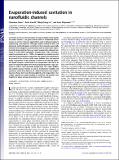Evaporation-induced cavitation in nanofluidic channels
Author(s)
Karnik, Rohit; Duan, Chuanhua; Lu, Ming-Chang; Majumdar, Arun
DownloadDuan-2012-Evaporation-induced.pdf (1.387Mb)
PUBLISHER_POLICY
Publisher Policy
Article is made available in accordance with the publisher's policy and may be subject to US copyright law. Please refer to the publisher's site for terms of use.
Terms of use
Metadata
Show full item recordAbstract
Cavitation, known as the formation of vapor bubbles when liquids are under tension, is of great interest both in condensed matter science as well as in diverse applications such as botany, hydraulic engineering, and medicine. Although widely studied in bulk and microscale-confined liquids, cavitation in the nanoscale is generally believed to be energetically unfavorable and has never been experimentally demonstrated. Here we report evaporation-induced cavitation in water-filled hydrophilic nanochannels under enormous negative pressures up to -7 MPa. As opposed to receding menisci observed in microchannel evaporation, the menisci in nanochannels are pinned at the entrance while vapor bubbles form and expand inside. Evaporation in the channels is found to be aided by advective liquid transport, which leads to an evaporation rate that is an order of magnitude higher than that governed by Fickian vapor diffusion in macro- and microscale evaporation. The vapor bubbles also exhibit unusual motion as well as translational stability and symmetry, which occur because of a balance between two competing mass fluxes driven by thermocapillarity and evaporation. Our studies expand our understanding of cavitation and provide new insights for phase-change phenomena at the nanoscale.
Date issued
2012-03Department
Massachusetts Institute of Technology. Department of Mechanical EngineeringJournal
Proceedings of the National Academy of Sciences
Publisher
National Academy of Sciences
Citation
Duan, C. et al. “Evaporation-induced Cavitation in Nanofluidic Channels.” Proceedings of the National Academy of Sciences 109.10 (2012): 3688–3693. ©2012 by the National Academy of Sciences
Version: Final published version
ISSN
0027-8424
1091-6490